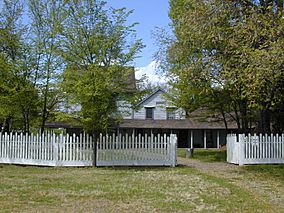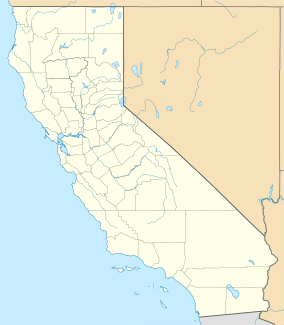Anderson Marsh State Historic Park facts for kids
Quick facts for kids Anderson Marsh State Historic Park |
|
|---|---|

The Ranch House at Anderson March State Historic Park
|
|
| Location | Lake County, California, USA |
| Nearest city | Clearlake, California |
| Area | 1,298 acres (5.25 km2) |
| Established | 1982 |
| Governing body | California Department of Parks and Recreation |
Anderson Marsh State Historic Park is a special place in California. It's a California State Historic Park and a nature reserve. This means it protects important natural areas and old buildings. The park keeps safe a big marsh, old places where the Pomo people lived, and historic ranch buildings.
You can find Anderson Marsh State Historic Park in Lake County, California, USA. It's located right where Cache Creek begins. This is at the southeast corner of Clear Lake. Clear Lake is the biggest natural lake completely inside California! The park is between the towns of Lower Lake and Clearlake. It's along State Route 53, north of Calistoga. The park is open all year long.
Contents
Nature at Anderson Marsh
Anderson Marsh Park has over 1,000 acres of beautiful nature. You can find hills covered in native grasses, oak woodlands, and large Tule marshes.
Habitats and Wildlife
The park protects several important natural areas, called habitats. These include:
- Freshwater marsh wetlands (swampy areas)
- Native grasslands (fields of natural grasses)
- California oak woodlands (forests with oak trees)
- Riparian woodlands (forests along rivers)
Many different animals live here. In the water, you might see large mouth bass, bluegill, catfish, and crappie. On land, there are western pond turtles, bats, gray foxes, frogs, garter snakes, mink, muskrats, opossums, raccoons, river otters, skunks, and toads.
Bird Watching
Anderson Marsh is a great spot for bird watching! About 151 different kinds of birds have been seen in the park. Some birds live there all the time, while others just visit during their migrations.
History of the Park
The area around Anderson Marsh has a very long and interesting history.
The Pomo People
The Southeastern Pomo Native Americans lived here for thousands of years. They were one of the largest groups of indigenous peoples in California before Europeans arrived. Their descendants still live nearby today.
The park has many archaeological sites. These are places where scientists find old tools and other items from the Pomo people. Some of these sites are among the oldest ever found in California. They show that people lived here over 10,000 years ago! A person named John Parker helped get these ancient sites recognized. He worked to make the area a new State Park.
Ranch Life
In 1854, a family named Grigsby built a small house here. Later, in 1884, a man from Scotland named John Still Anderson bought the land. He moved there with his wife and six children. The house they built is now known as the Ranch House. The Anderson family ran a dairy farm and raised cattle. Their family lived in the Ranch House until the 1960s.
The State of California bought the land in 1982. That's when it became Anderson Marsh State Historic Park. It was named after John Still Anderson.
Things to Do at the Park
Anderson Marsh State Historic Park offers many fun activities for visitors.
Activities and Programs
You can enjoy:
- Bird watching: Look for all the different bird species.
- Hiking: Explore the park's trails.
- Bluegrass musical festival: Enjoy live music events.
- Interpretive programs: Learn about the park's nature and history.
- Historic ranch home: Visit the old Ranch House to see how people lived long ago.
Anderson Marsh Interpretive Association (AMIA)
The Anderson Marsh Interpretive Association (AMIA) is a group of volunteers. They started in 1984 to help the park. Their main goal is to teach people about the park's history and nature.
AMIA also helps the park in many other ways. They fund projects like:
- Protecting and restoring natural habitats.
- Building and taking care of trails so everyone can use them.
- Creating displays and information to help visitors learn.
- Fixing up park buildings and historical items.
- Getting new things for educational programs.
Park Closure Proposal
In 2012, Anderson Marsh State Historic Park was one of many California state parks that faced a possible closure. This was due to budget cuts in California. The park was supposed to close in July 2012. However, this park and many others had faced similar closure threats before, in 2008, and were saved. Thanks to efforts from the community and groups like AMIA, the park remained open.



